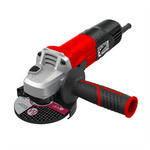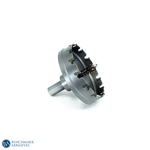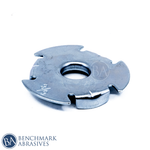
What are Different Types of Circular Saw Blades?

Circular saw blades are strong cutting tools to cut wood, metal, plastic, concrete, and more. Any circular saw, however, is just as effective as the blade you use, and for the job you are working on, you must choose an appropriate circular saw blade.
What are Circular Saw Blades?
Circular saw blades are essential cutting tools that are primarily used for woodworking applications. It is a fast-spinning circular disc featuring sharp teeth all around the edges so that it can effectively cut through wood.
Features of Circular Saw Blades
Circular saw blades have the following features:
-
Teeth: this is an important part of a circular saw blade that enables it to cut through wood. They are pointed, triangular extensions that emerge from the blade's outer edge. Several tooth designs are designed for particular cutting jobs. This comprises crosscutting, which cuts across the grain, and ripping, which cuts along it.
-
Plate: the plate in the circular saw offers a strong base for the blade. It makes sure that the blade spins smoothly or accurately. It also ensures that the blade does not vibrate or wobble, which can cause inaccurate cuts and damage the workpiece.
-
Arbor hole: The saw blade is secured to the arbor or spindle via the hole in the middle of the blade. Make sure that the hole size is similar to the arbor’s diameter for a tight and safe fit.
Types of Circular Saw Blades
There are various kinds of circular saw blades, such as Standard, Rim blades, Turbo Rim, Segmented blades, and Abrasive blades. All of them have their specific uses.
Here, we have all the details you need about the types of circular saw blades.
1. Standard Circular Saw Blades
Standard circular saw blades are perfect for cutting hardwood & wood composites. The blade tooth helps to determine the rotating speed and finishing cut. A circular saw blade with more teeth produces a superior finish, whereas one with fewer teeth cuts more quickly.
Gullets present between the teeth help to eliminate the wood chips from the workpiece. As it expands and contracts during use, expansion slots cut into the rim help prevent the blade from warping. They also minimize vibration, providing a smoother cut.
2. Rip-cut & Cross-cut Blades
Rip-cut wood grain cutting blades (along the length of a board) have fewer teeth, usually 16 to 40. The teeth are designed to cut aggressively, and deep gullets provide effective chip removal. They are designed for cutting through the wood (across the face of a board); the cross-cut blades are between 40 and 80 teeth long and are built for clean cutting. Smaller gullets separate the teeth.
Combination blades can make both rip cuts and crosscuts. They have different teeth groupings separated by deep gullets. For ripping, each group has one tooth, and four for crosscutting.
3. Continuous-Rim Blades
Continuous-rim blades are a kind of diamond-edged blade designed for use on materials such as tile and slate (sometimes called diamond blades). Diamonds attached to the blade's edge cut through the material.
Continuous-rim blades provide a very clean finish. Some operate only in dry-cutting applications, some are for wet-cutting applications, and some can operate in any application.
4. Turbo-Rim Blades
They are similar to continuous-rim blades. Turbo-rim blades are diamond blades that have a serrated rim that cuts materials such as brick and concrete. These blades cut more powerfully than continuous-rim blades but don't leave as clean of a finish. Some work only for dry-cutting, while others are ideal for both wet and dry applications.
5. Segmented Blades
Segmented blades are often cut with diamond tip but have a rim identical to those on a regular blade separated by gullets. The segments produce the diamond blades' most violent cut.
These blades cut quicker than the other styles and can handle tough materials, such as concrete and stone, but leave a rougher finish. Others work for dry-cutting, much like continuous- and turbo-rim blades, while others can handle wet or dry applications.
6. Abrasive Blades
Abrasive blades are used to cut hard materials such as concrete and stone. Some abrasive blades are acceptable, like a metal-cutting circular saw blade. They don't have teeth like the blades of diamonds. They are cut with an abrasive material such as aluminum oxide or carbide silicon.
Looking for more circular saw blades. Let’s have a list of some common types of circular saw blades based on their application and uses.
General Types of Circular Saw Blades and Uses
7. Cross Cutting Blades
Cross Cutting blades are perfect for cutting hard and softwood materials and sheets. Compared to other circular blades, these blades have more teeth and a shallow gullet, so they are best for wood cutting. Cross Cutting blades provide a smooth and clean cut at a slow speed.
8. Plywood Blade
The plywood blade has more teeth than the crosscutting blade since the plywood flakes and chips are not rough. They usually have more than 40 teeth. The blade is intended to be used on smooth surfaces, thereby helping to minimize wood splintering during cutting.
9. General-Purpose Blades
General-purpose blades are also known as combination blades; they are somehow placed between crosscut and rip-cut blades. As we have already discussed, crosscut and rip-cut blades in this article (see section 2).
10. Ripping Blades
These blades are not designed to cut through a grain of the wood but along with it. They distinguish a few teeth, not more than 24. They have deep gullets and are ideal for the faster development of rough cuts.
11. Finishing Blades
Finishing blades are used on wood and other soft materials to make clean and effective cuts. They allow cuttings on a wood that will most likely be visible after completion of the desired job. They have more teeth for making smooth cuts. They don't do any harm to the wood due to the extra teeth.
12. Dado Blade
A dado blade is a type of circular saw blade commonly used with a table saw, or radial arm saw. It is used in woodworking to cut dice or grooves. These blades are usually applied to cut precise grooves in the wood.
13. Thin Kerf
These kinds of blades are crafted to cut through the wood in a shallow way. The width of a cut is regarded as a "kerf." These blade types are often used for cutting dimensional wood material. In rough woods, they are not meant to be used as it will cause them to flex, making it difficult to have a straight cut.
14. Masonry Blades
Masonry saw blades are designed for cutting through the materials of brick, stone, ceramic, tile, and other kinds of masonry. In different applications, such as detail work, tile work, and precision cutting, masonry blades can be used.



































































